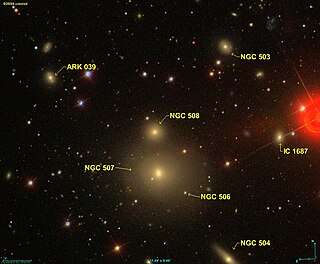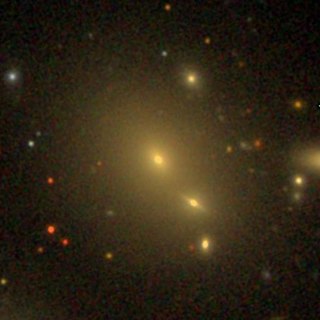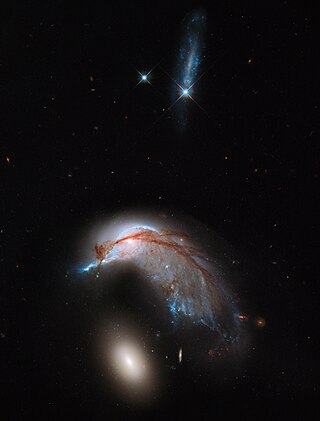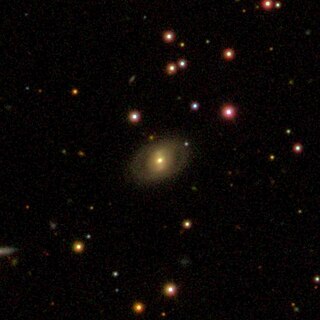
NGC 4088 is an intermediate spiral galaxy in the constellation Ursa Major. The galaxy forms a physical pair with NGC 4085, which is located 11′ away.

The Atlas of Peculiar Galaxies is a catalog of peculiar galaxies produced by Halton Arp in 1966. A total of 338 galaxies are presented in the atlas, which was originally published in 1966 by the California Institute of Technology. The primary goal of the catalog was to present photographs of examples of the different kinds of peculiar structures found among galaxies.

Arp 87 is a pair of interacting galaxies, NGC 3808A and NGC 3808B. They are situated in the Leo constellation. NGC 3808A, the brighter, is a peculiar spiral galaxy, while NGC 3808B is an irregular galaxy.

NGC 3432 is a spiral galaxy that can be found in the constellation Leo Minor. It is seen edge-on and with its current interaction with UGC 5983, a nearby dwarf galaxy, it features tidal filaments and intense star formation, which is why it was listed in Halton Arp's Atlas of Peculiar Galaxies.

NGC 14 is an irregular galaxy in the Pegasus constellation. It was included in Halton Arp's Atlas of Peculiar Galaxies, under the section "Galaxies with the appearance of fission," since the irregular appearance of this galaxy causes it to look like it is coming apart. It was discovered on September 18, 1786, by William Herschel.

NGC 507, also known as Arp 229, CGCG 502-67, MCG 5-4-44, PGC 5098, UGC 938, and V V 207, is a lenticular galaxy in the constellation Pisces. It was described as being "very faint", "pretty large", "round", "brighter in the middle", and "south of NGC 508" by John Dreyer in the New General Catalogue. The two galaxies are a part of the Atlas of Peculiar Galaxies, where NGC 507 is described as "Circular or near circular rings of small density difference."

NGC 523, also known as Arp 158, from the ARP catalog is a spiral galaxy located in the constellation Andromeda. It was discovered separately by William Herschel on 13 September 1784, and by Heinrich d'Arrest on 13 August 1862. d'Arrest's discovery was listed as NGC 523, while Herschel's was listed as NGC 537; the two are one and the same. John Dreyer noted in the New General Catalogue that NGC 523 is a double nebula.

NGC 7035 and NGC 7035A are a pair of interacting lenticular galaxies located around 400 to 430 million light-years away in the constellation of Capricornus. The main galaxy, NGC 7035 was discovered by astronomer Frank Muller in 1886.

NGC 7603 is a spiral Seyfert galaxy in the constellation Pisces. It is listed in the Atlas of Peculiar Galaxies. It is interacting with the smaller elliptical galaxy PGC 71041 nearby.

NGC 4647 is an intermediate spiral galaxy estimated to be around 63 million light-years away in the constellation of Virgo. It was discovered by astronomer William Herschel on March 15, 1784. NGC 4647 is listed along with Messier 60 as being part of a pair of galaxies called Arp 116; their designation in Halton Arp's Atlas of Peculiar Galaxies. The galaxy is located on the outskirts of the Virgo Cluster.

NGC 4633 is a spiral galaxy located about 70 million light-years away in the constellation of Coma Berenices. It is interacting with the nearby galaxy NGC 4634. NGC 4633 was discovered by astronomer Edward D. Swift on April 27, 1887. It was rediscovered on November 23, 1900, by astronomer Arnold Schwassmann and was later listed as IC 3688. NGC 4633 is a member of the Virgo Cluster.

NGC 497 is a barred spiral galaxy approximately 336 million light-years away from Earth in the constellation of Cetus. It was discovered by French astronomer Édouard Stephan on November 6, 1882.

NGC 508, also occasionally referred to as PGC 5099 or UGC 939, is an elliptical galaxy in the constellation Pisces. It is located approximately 247 million light-years from the Solar System and was discovered on 12 September 1784 by British astronomer William Herschel.

NGC 6040 is a spiral galaxy located about 550 million light-years away in the constellation Hercules. NGC 6040 was discovered by astronomer Édouard Stephan on June 27, 1870. NGC 6040 is interacting with the lenticular galaxy PGC 56942. As a result of this interaction, NGC 6040's southern spiral arm has been warped in the direction toward PGC 56942. NGC 6040 and PGC 56942 are both members of the Hercules Cluster.

NGC 6041 is a giant elliptical galaxy located about 470 million light-years away in the constellation Hercules. NGC 6041 has an extended envelope that is distorted towards the galaxy pair Arp 122. NGC 6041 is the brightest galaxy (BCG) in the Hercules Cluster. The galaxy was discovered by astronomer Édouard Stephan on June 27, 1870.

NGC 2936 is an interacting spiral galaxy located at a distance of 326 million light years, in the constellation Hydra. NGC 2936 is interacting with elliptical galaxy NGC 2937, located just beneath it. They were both discovered by Albert Marth on Mar 3, 1864. To some astronomers, the galaxy looks like a penguin or a porpoise. NGC 2936, NGC 2937, and PGC 1237172 are included in the Atlas of Peculiar Galaxies as Arp 142 in the category "Galaxy triplet".

NGC 739 is a spiral galaxy approximately 193 million light-years away from Earth in the constellation of Triangulum.

Arp 166 is a pair of interacting elliptical galaxies approximately 225 million light-years away from Earth in the constellation of Triangulum. The two galaxies, NGC 750 and NGC 751, are listed together as Arp 166 in the Atlas of Peculiar Galaxies.

NGC 750 is an elliptical galaxy approximately 225 million light-years away from Earth in the constellation of Triangulum. It forms a close pair of interacting galaxies together with the nearby NGC 751 galaxy. The pair is listed as Arp 166 in the Atlas of Peculiar Galaxies.

NGC 751 is an elliptical galaxy approximately 225 million light-years away from Earth in the constellation of Triangulum. It forms a close pair of interacting galaxies together with the nearby NGC 750 galaxy. The pair is listed as Arp 166 in the Atlas of Peculiar Galaxies.



















